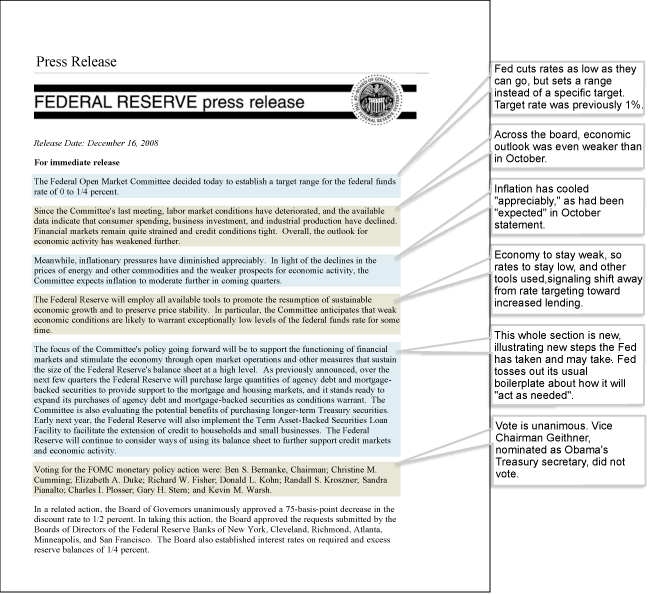-
The Federal Reserve – FOMC Statement
The Federal Open Market Committee decided today to establish a target range for the federal funds rate of 0 to 1/4 percent…The Federal Reserve will employ all available tools to promote the resumption of sustainable economic growth and to preserve price stability. In particular, the Committee anticipates that weak economic conditions are likely to warrant exceptionally low levels of the federal funds rate for some time. The focus of the Committee’s policy going forward will be to support the functioning of financial markets and stimulate the economy through open market operations and other measures that sustain the size of the Federal Reserve’s balance sheet at a high level. As previously announced, over the next few quarters the Federal Reserve will purchase large quantities of agency debt and mortgage-backed securities to provide support to the mortgage and housing markets, and it stands ready to expand its purchases of agency debt and mortgage-backed securities as conditions warrant. The Committee is also evaluating the potential benefits of purchasing longer-term Treasury securities. Early next year, the Federal Reserve will also implement the Term Asset-Backed Securities Loan Facility to facilitate the extension of credit to households and small businesses. The Federal Reserve will continue to consider ways of using its balance sheet to further support credit markets and economic activity. -
The Wall Street Journal – Fed’s Cut Is a Zero-Sum Game
Investors are trying to have their cake and eat it, too. No sooner had the U.S. Federal Reserve cut rates to practically zero than both stocks and long-dated Treasuries rallied. Short term, this could make sense, particularly if the Fed follows through on buying long-dated Treasuries. But over time, one set of investors is going to get hurt. If the Fed’s drastic rate cut, along with the possibility of more aggressive purchases of mortgage-backed securities and longer-dated Treasuries, successfully revive the economy, then investors are right to bid up stocks. If, on the other hand, the Fed’s actions fail and the economy continues to falter, stocks will have farther to fall even as low-yielding Treasuries look good in a deflationary environment. So who’s right? -
The Wall Street Journal – Bernanke Goes All In
The unhappy truth, however, is that markets have cheered previous Fed easing, only to be disappointed over time. Former Fed Vice Chairman Alan Blinder captured the point when he told the Journal yesterday that “The Fed gets an ‘A’ or ‘A-minus’ for effort and not very good marks for results.”…Now the Fed is embarking on a further monetary adventure and asking the world to believe that this time it will work. We sincerely hope it does. And if a lack of liquidity is the problem in some credit instruments, the Fed’s direct purchase of those assets should contribute to a credit thaw. It has already contributed to a decline in mortgage rates. However, the larger economic problem today isn’t an overall lack of liquidity. It is fear and uncertainty. -
Bloomberg.com – Caroline Baum: Fed Targeting Zero Isn’t the Same as Doing Zip
Banks can now borrow at an interest rate of virtually zero, secure in the knowledge that the Fed isn’t going to raise the funds rate anytime soon. Policy makers expect economic conditions to “warrant exceptionally low levels” for some time. Katy bar the door when things change. The Fed’s balance sheet has ballooned 155 percent in the past year, most of it in the last three months. When confidence and the willingness to take risk return, the Fed will have to demonstrate the same agility it has shown during the crisis and drain the $590 billion of excess reserves banks now hold. (Prior to the credit crisis, banks held an average of $1 billion to $2 billion of excess reserves.) It’s these reserves that have the potential to multiply into money. A promise made by the Fed to hold overnight rates at close to zero is a promise kept only if inflation expectations stay muted. Before the Fed’s balance sheet shrinks, however, it’s going to get a lot bigger.
Comment The dropping of rates to a range of 0% to 0.25%, although a slightly more aggressive cut than was expected, was not shocking. The Federal Reserve’s announcement to buy agency debt and MBS, regardless of its effect on their balance sheet, was already known. Likewise, the possibility of having the Federal Reserve buy longer-term Treasuries has been hinted at in the past.
Given all these known quantities in the FOMC statement, why were the markets whipped into a frenzy yesterday? The Federal Reserve announced, “In particular, the Committee anticipates that weak economic conditions are likely to warrant exceptionally low levels of the federal funds rate for some time.”
The Federal Reserve has basically guaranteed the markets that the funds rate will be 0% for the foreseeable future. In doing so, the Federal Reserve has returned to the old days of signaling future policy to influence the market’s present actions. In 2005 the Cleveland Federal Reserve even offered a study on Greenspan’s use of the phrase “considerable period” in his FOMC communiqué. By saying the funds rate will be 0% for the foreseeable future, the Federal Reserve is offering increased transparency.
If the cost to borrow is 0% today and will be 0% tomorrow, the Federal Reserve’s hope is that this will help stimulate investments in riskier assets.
